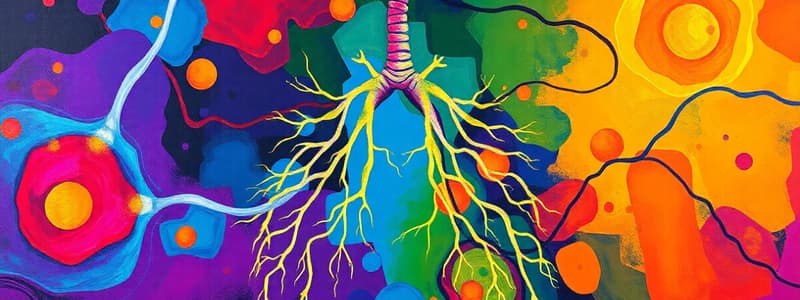Podcast
Questions and Answers
What type of reaction is characterized by the absorption of energy?
What type of reaction is characterized by the absorption of energy?
- Exergonic
- Endergonic (correct)
- Spontaneous
- Exothermic
Which process involves the breaking of bonds and the release of energy?
Which process involves the breaking of bonds and the release of energy?
- Decomposition (correct)
- Synthesis
- ATP breakdown (correct)
- Endergonic reaction
Which term describes the gain of electrons in a chemical reaction?
Which term describes the gain of electrons in a chemical reaction?
- Reduction (correct)
- Oxidation
- Synthesis
- Decomposition
What is a characteristic of exergonic reactions?
What is a characteristic of exergonic reactions?
Which of the following correctly represents a synthesis reaction?
Which of the following correctly represents a synthesis reaction?
Flashcards
Endergonic Reaction
Endergonic Reaction
A chemical reaction that absorbs energy from its surroundings.
Exergonic Reaction
Exergonic Reaction
A chemical reaction that releases energy into its surroundings.
Reduction
Reduction
A process where a substance gains electrons, often associated with a decrease in oxidation state.
Oxidation
Oxidation
Signup and view all the flashcards
ATP
ATP
Signup and view all the flashcards
Study Notes
Chapter 3: Energy, Chemical Reactions, and Cellular Respiration
- This chapter covers energy, chemical reactions, and cellular respiration.
- Learning objectives include comparing and contrasting potential and kinetic energy and their relation to the Laws of Thermodynamics.
- Learning objectives also include explaining the three major types of chemical reactions (synthesis, decomposition, and oxidation-reduction).
- Learning objectives also detail how reactions are categorized (anabolic, catabolic, endergonic, exergonic, reversible, irreversible).
Energy
- All living organisms need energy.
- Energy is required for muscle power, blood pumping, nutrient absorption, gas exchange, synthesizing new molecules, and establishing cellular ion concentrations.
Energy and ATP
- Glucose is broken down through metabolic pathways (cellular respiration).
- This process forms ATP, the "energy currency" of cells.
- ATP is a nucleotide composed of a nitrogenous base (adenine), a ribose sugar, and three phosphate groups.
- Covalent bonds between the last two phosphate groups store energy.
- Energy is released when these bonds are broken.
Energy and ATP (Continued)
- ATP formation (endergonic reaction) requires energy input. Breaking down fuel molecules, like glucose provides this energy.
- ATP splitting (exergonic reaction) releases energy, used for cellular processes like body movement.
Energy
- Energy is the ability to do work.
- Two main types of energy are potential energy (stored energy) and kinetic energy (energy of motion).
- Potential energy can be converted into kinetic energy and vice versa.
- Kinetic energy is the movement of ions, molecules, etc. across a membrane.
- Potential energy can be stored in concentration gradients.
Chemical Energy
- Chemical energy is a form of potential energy.
- It is stored in the chemical bonds of molecules.
- Energy is released when these bonds are broken.
- Examples of molecules that store chemical energy include triglycerides, glucose and ATP.
- Chemical energy powers body processes like movement and synthesis.
Kinetic Energy
- Kinetic energy includes electrical energy (ion movement), mechanical energy (muscle contractions), sound energy (vibration), radiant energy (light), and heat energy (molecular motion).
Laws of Thermodynamics
- Thermodynamics is the study of energy transformations.
- The first law states that energy cannot be created or destroyed, but can change form.
- The second law states that some energy is lost as heat during transformations.
Chemical Equations
- Chemical equations describe chemical reactions and show what reactants form what products.
- Reactants are the starting materials, products are the end results.
- Chemical reactions involve breaking and forming bonds.
Classification of Chemical Reactions
- Chemical reactions are categorized based on changes in chemical structure, chemical energy, and reversibility.
Classification of Chemical Reactions (Continued)
- Three main types of chemical reactions based on structure: synthesis, decomposition, and exchange reactions.
Synthesis Reaction
- Two or more structures combine to form a larger structure.
- An example in the body is dehydration synthesis, which builds dipeptides from amino acids.
- Anabolism encompasses all synthesis reactions in the body.
Decomposition Reaction
- A large molecule breaks down into smaller structures.
- An example is hydrolysis, where sucrose breaks down into glucose and fructose.
- Catabolism includes all decomposition reactions in the body.
Exchange Reaction
- Groups are exchanged between two structures.
- It has components of both decomposition and synthesis.
- Formation of ATP in muscle tissue is an example of an exchange reaction.
Oxidation-Reduction (Redox) Reaction
- Redox reactions involve the transfer of electrons between structures.
- Oxidation involves loss of electrons, reduction involves gain of electrons.
- Reactions always occur simultaneously.
- An example is NAD+ to NADH, where NAD+ is reduced to NADH as it gains electrons.
Classification of Chemical Reactions (Continued)
- Two categories related to energy: exergonic reactions and endergonic reactions.
- Exergonic reactions release energy, while endergonic reactions require energy input.
Exergonic and Endergonic Reactions (Continued)
- In exergonic reactions, reactants have more energy than the products, and energy is released.
- In endergonic reactions, reactants have less energy than products, and energy is absorbed.
- Examples illustrated in graphs that show potential energy change across a reaction.
- Exergonic reactions often relate to decomposition, while endergonic relate to synthesis of molecules
Reversible Reactions
- These reactions proceed in both forward and reverse directions, characterized by no net change in concentration of reactants and products.
- These reactions reach a state of equilibrium.
- Key example: Carbonic Acid reaction, converting between carbon dioxide and bicarbonate.
Important Note:
- The diagrams illustrate the processes and the relationships between components.
Studying That Suits You
Use AI to generate personalized quizzes and flashcards to suit your learning preferences.


